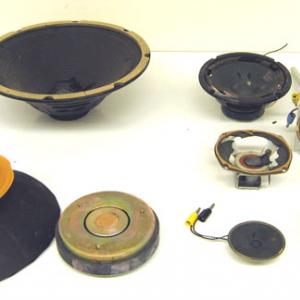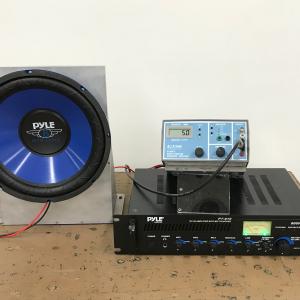College of Liberal Arts & Sciences
3E20.10 - Loudspeakers
Show and tell the major parts and components of loudspeakers.
This speaker can be used to show large oscillations of the speaker cone. Use 5 to 10 Hz. on the function generator. The 600 watt amplifier will have to be turned all the way up to see to so oscillations that are visible in the large classrooms. The speaker is rated to take this amount of wattage. The best oscillations occur around 8 Hz.
- Antonio Eff-Darwich, Adan Yanes-Gomez, "Mind Control Helmet: A Fun Demonstration About Sound and Electromagnetism", TPT, Vol. 61, #3, March 2023, p. 195.
- Kasey Wagoner and Daniel Flanagan, "Speaking of E&M", TPT, Vol. 57, #2, Feb. 2019, p. 78.
- William Reitz, "Two Sound Ideas", TPT, Vol. 55, #6, Sept. 2017, p. 378.
- Rhett Herman, "As Simple as Possible", TPT, Vol. 40, # 2, Feb. 2002, p. 182.
- Molly Johnson, "Sound Science - A Simple and Robust Hands-on Loudspeaker Activity", TPT, Vol. 37, # 6, p. 350, Sept. 1999.
- Peter Heller, "Drinking-Cup Loudspeaker - A Surprise Demo", TPT, Vol. 35, # 6, p. 334, Sept. 1997.
- Allen Keeney and Brant Hershey, "Making Your Own Dynamic Loudspeaker", TPT, Vol. 35, # 5, p. 297- 299, May 1997.
- Chris Chiaverina, "Softspeakers", TPT, Vol. 24, # 1, Jan. 1986, p. 55.
- W- 425: "Bite-a-Phone", DICK and RAE, Physics Demo Notebook.
- "Nanotube Loudspeakers", Physics Today, Vol. 62, #1, Jan 2009, p. 17.
- Rob Sabin, "Build Your Own Speakers", Popular Mechanics, Aug 2008, p. 115.
- Rafi Letzter, "Learn to Make Speakers from Post-Its", Popular Science, Feb. 2015, p. 67.
- Corinne Iozzio, "Speakers From Space", Popular Science, Jan. 2013, p. 14.
- Mark Davids, et al., "The Photophone", Teaching about Lightwave Communications, AAPT, 1994, p. 3-7.
- Allen Keeney and Brant Hershey, "Making Your Own Dynamic Loudspeaker", Apparatus for Teaching Physics, p. 126, Edited by Karl Mamola.
- H. Richard Crane, "Never Throw a 2-Inch Speaker Away: It Has Many Uses", How Things Work, AAPT, 1992 p. 120.
- H. F. Olson, "Modern Sound Reproduction", Van Nostrand Reinhold Co., 1972, p. 19.
- Cy Tymoney, "Sneaky Intercom", Sneakiest Uses for Everyday Things, Andrews McMeel, 2007, p. 39.
- William Gurstelle, "Crispy, Crunchy Audio", Popular Science, March 2013, p. 71.
- Curt Suplee, "Resistance: Pros and Cons", Everyday Science Explained, National Geographic, p. 96.
- Grant Mellor, "The Juice-Can Speaker", Flying Tinsel, 1993, p. 110.
- "Loudspeaker", The New Illustrated Science of Invention Encyclopedia: The New How it Works Vol. 11, H.S. Stuttman Inc., p. 1482.
Disclaimer: These demonstrations are provided only for illustrative use by persons affiliated with The University of Iowa and only under the direction of a trained instructor or physicist. The University of Iowa is not responsible for demonstrations performed by those using their own equipment or who choose to use this reference material for their own purpose. The demonstrations included here are within the public domain and can be found in materials contained in libraries, bookstores, and through electronic sources. Performing all or any portion of any of these demonstrations, with or without revisions not depicted here entails inherent risks. These risks include, without limitation, bodily injury (and possibly death), including risks to health that may be temporary or permanent and that may exacerbate a pre-existing medical condition; and property loss or damage. Anyone performing any part of these demonstrations, even with revisions, knowingly and voluntarily assumes all risks associated with them.

